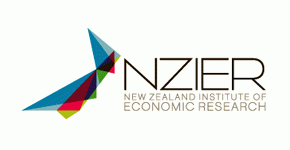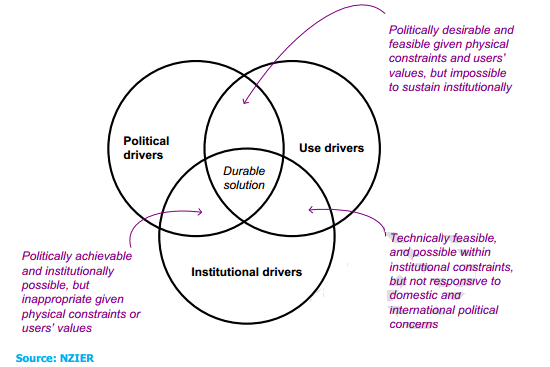
Content supplied by NZIER
Good water management is hampered by uncertainty
Increased competition for water, concerns about water quality, and major irrigation investments being considered all point to the need for better information on how society uses and values water and better institutions to manage the use of water.
Durable water policy to support the sensible use of water requires an in-depth understanding of the characteristics of the water system within New Zealand and the policy challenges it presents. The main problem with New Zealand water policy is uncertainty. The uncertainty is driven by increased competition for water, a lack of understanding of society’s preferences about how we use and value water, a lack of scientific information about water and inertia on the part of users and institutions.
This paper has been prepared as part of NZIER’s public good programme to provide independent advice on water policy. We explore the current and expected future challenges facing water management, and review the history of water policy in New Zealand. We note that there is a broad consensus that the current approach under the RMA is flawed, and there is momentum to develop a multi-faceted framework that examines those challenges to assist stakeholders in thinking about what needs to be done for freshwater policy.
Our findings will not come as a surprise to policy makers, scientists and economists working in this field. But as we conclude, durable solutions require broad public and political support. With this paper we seek to provide a broader group of people access to the types of trade-offs that need to be considered.
Current challenges point to the need for change
The challenges facing water management in New Zealand are nuanced:
- there is significant variation of water quantity issues by catchments – scarcity and quality are not an issue across all of New Zealand all of the time, but
- most regions have at least one river (surface water) or aquifer (groundwater) that is either fully or over-allocated, or likely to become so in the next one to five years
- 39% of groundwater sites and 44% of lakes have nutrient levels above natural levels. However, they are not bad by international standards
- the full impacts of past and present water uses on water quality have yet to fully materialise
- the growth of agricultural (mainly dairying) and urbanisation are the main sources of water quantity and quality problems, and they are expected to continue.
The main consequence of falling water availability is increasing competition for water between different users and deteriorating water quality in some catchments.
We also recognise that there are challenges arising from the Treaty of Waitangi, but have not explored them in this report.
New Zealand water management has been characterised by inconsistency
New Zealand has had little consistent water policy over time. The ad-hoc responses of the 1840 – 1930s were replaced with an interventionist approach for the period from 1941 – 1989. Since then, the Resource Management Act (RMA) has given regional councils the responsibility of managing the complex trade-offs associated with water management.
The weaknesses of the current RMA system are well known, and have become clearer as water scarcity and quality issues have become more prevalent. The first-in, first-served mechanism is inefficient for allocating water; the lack of flexibility restricts improvements to water allocation, and there are large gaps in information and data.
There is scope to craft better policy, informed by overseas lessons
The lack of consistency in New Zealand's historical water management is a two-edged sword. It makes planning and investing around water use and infrastructure uncertain, which reduces investment in solutions. However, it also means that there is little historical precedent that must be respected; New Zealand has considerable scope to craft new and appropriate policy.
What we can learn from history however, is that without a clear understanding of problems we face and how New Zealanders value water (both from a market and non-market perspective), and without engagement of those affected by regulation, then decisions are likely to be ad hoc, short term and require constant revision.
Overseas experience points to some potential solutions: focusing on achieving the most value from water, using science to inform decision-making, developing water markets, being careful with allocations and using policy design to achieve social and environmental goals. \
Frameworks help us to identify the trade-offs inherent in water policy
We present several different frameworks for thinking about water. A framework is a representation of reality that identifies the important elements and describes the structure of their relationships. Frameworks are often drawn as diagrams or flowcharts in reports, but they are truly useful when people can carry them around in their heads as mental models to aid their thinking.
The multiple drivers framework recognises that decisions about water use must take place in a specific political and institutional context, without forgetting the physical constraints or the values of water users. This provides a platform to understand water use within the catchment context.
Water management relies on:
- use drivers, recognising water use is a combination of physical, technological, social, and economic drivers
- institutional drivers that reflect the existing legislative framework that manages water
- political drivers such as concerns about perceived community values or timing of policies. Also, international pressures or conforming to international standards.
Multiple drivers framework

The use drivers (associated with the multiple drivers framework) can be considered in a general equilibrium context, which combines the physical descriptions of the possibilities and limits of water with the multiple ways that people can derive value from water, and gives us a way to talk about limits, feasibility, values and trade-offs.
The ecosystem services framework allows us to understand the physical and environmental limits of water use, as well as the multiple services that water performs for society and the environment.
Total economic value is a way to discuss the many different ways that water users derive value from water, both the marketed values and the non-market values.
Taken together, along with consideration of New Zealand’s history and overseas experiences, these frameworks provide the tools for thinking about water issues, a way of triangulating results, and working towards durable water management solutions.
Practical application of these frameworks highlights potential solutions
Practical application of water management solutions is required for the best use of water. Applying the frameworks to key issues illustrates how New Zealand might work towards solutions:
- water trading can offer possible improvements in allocation so that water is put to its best use. However, giving the opportunity to trade does not mean that trading will necessarily take place in a catchment. Encouraging water allocations to be traded also requires institutional and political support
- water pricing overseas shows that it offers possible improvements and flexibility for achieving water management aims (i.e. the water is put to its best use), but water pricing is only one of the factors that can lead to better use of water. To be useful, water pricing also requires institutional and political support to achieved desired aims
- ensuring that there is public support for public irrigation schemes is a crucial step in their development. This requires transparency so that the public understand why schemes have been undertaken and who benefits from the scheme and how
- environmental set-asides appear to be a useful and appropriate tool in a well-functioning water management system. They can be tailored to meet the needs of specific catchments and the needs of New Zealanders and allow for flexibility in the water management system
- a water management system relies on policy-related research. Without performance metrics, decision makers rely on their own experience and instincts that may or may not lead to good water management policy. This ‘hit or miss’ approach to such an important issue is unlikely to lead to good outcomes. Policy makers need to understand the strengths and weaknesses of the research and be active in challenging researchers to answer the pertinent policy questions.
The road ahead: our recommendations
Good use of water requires an understanding of the value of water to the various water users. With the right information and framework for understanding water, there is a potential to create durable management of water resources over time by developing regulation that allocates water in a way that reflects how stakeholders value it and responds to changes in users’ preferences, technology and emerging environmental outcomes. The work and reforms in this space, such as the Land and Water Forum and the National Objectives Framework for freshwater, are on the right track but more needs to be done.
Our key recommendations are:
1. Reform the allocation and reallocation mechanisms. Allow water rights to be traded to ensure water flows to its best use.The current first-in first-served approach is not an appropriate allocation mechanism
2. Impose environmental externality limits based on case-specific evaluation. Don't use one-size-fits-all limits but design the mechanisms that can achieve the 'largest bang-for-your-buck' in environmental terms.
3. Invest in coordinated research. The difficulty with water policy is that it requires information from a range of disciplines (e.g. agricultural science, natural resource and environmental economics, hydrology etc.) across a range of geographical scales (e.g. farm, catchment, region). Greater coordination of research would allow New Zealand to get the greatest improvement in water policy from the research investment
4. Centralise key water management decisions. Our frameworks have emphasised the importance of political and institutional support. We believe the central Government and its agencies must provide the overarching water management principles and frameworks. This would provide consistency in key areas such as the design of allocation and compensation mechanisms, and environmental policies. It would also allow regional councils to focus on the regional specifics rather than designing water management systems from the ground up.
-------------------------------------------------------------------
This is the executive summary of an NZIER report publsihed today. The full Report will be available here soon.
1 Comments
A good piece of work. Need lots of science involved to ensure that the environmental limits are sustainable and acceptable. All water used should all cost money (just like royalties for mineral extractions) and not just cost the power and infrastructure. Encourages people to become more efficient with their use.
We welcome your comments below. If you are not already registered, please register to comment.
Remember we welcome robust, respectful and insightful debate. We don't welcome abusive or defamatory comments and will de-register those repeatedly making such comments. Our current comment policy is here.